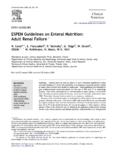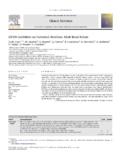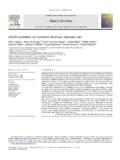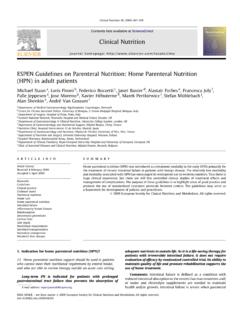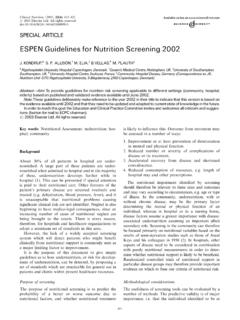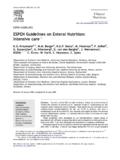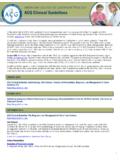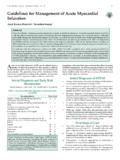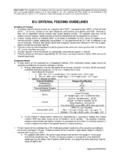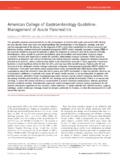Transcription of ESPEN Guidelines on Enteral Nutrition: Pancreas
1 Clinical nutrition (2006)25, 275 284 ESPEN GUIDELINESESPEN Guidelines on Enteral nutrition : Pancreas $R. Meiera, , J. Ockengab, M. Pertkiewiczc, , N. Milinice, J. MacFief,DGEM:$$C. Lo ser, V. KeimaDepartment of Gastroenterology, Kantonsspital Liestal, Liestal, SwitzerlandbDepartment of Gastroenterology, CCM, Charite -Universita tsmedizin Berlin, Berlin, GermanycDepartment of nutrition and Surgery, Central Clinical Hospital, Warsaw, Polandd1st. Department of Gastroenterology, MAV Hospital, Budapest, HungaryeDepartment of Gastroenterology, University Hospital Bezanijska kosa, Belgrade, Serbia-MontenegrofDepartment of Surgery, Scarborough Hospital, Scarborough, UKReceived 21 January 2006; accepted 21 January 2006 KEYWORDSG uideline;Clinical practice; Enteral nutrition ;Oral nutritionalsupplements;Tube feeding;Pancreatitis;Undernutrition;Maln utritionSummaryThe two major forms of inflammatory pancreatic diseases, acute andchronic pancreatitis, require different approaches in nutritional management, whichare presented in the present guideline.
2 This clinical practice guideline givesevidence-based recommendations for the use of ONS and TF in these patients. It wasdeveloped by an interdisciplinary expert group in accordance with officiallyaccepted standards and is based on all relevant publications since 1985. Theguideline was discussed and accepted in a consensus mild acute pancreatitis Enteral nutrition (EN) has no positive impact on thecourse of disease and is only recommended in patients who cannot consume normalfood after 5 7 days. In severe necrotising pancreatitis EN is indicated and should besupplemented by parenteral nutrition if needed. In the majority of patientscontinuous TF with peptide-based formulae is possible. The jejunal route isrecommended if gastric feeding is not chronic pancreatitis more than 80% of patients can be treated adequately withnormal food supplemented by pancreatic enzymes. 10 15% of all patients requirenutritional supplements, and in approximately 5% tube feeding is full version of this article is available European Society for Clinical nutrition and Metabolism.
3 All rights IN $ - see front matter&2006 European Society for Clinical nutrition and Metabolism. All rights :EN, Enteral nutrition (both oral nutritional supplements and tube feeding); IU, international units; PEG,percutaneous endoscopic gastrostomy; MCT, medium chain triglycerides; ONS, oral nutritional supplements; TF, tube feeding$For further information on methodology see Schu tz et further information on definition of terms see Lochs et Corresponding author. Tel.: +41 61 9252187; fax: +41 61 (R. Meier).$$The authors of the DGEM (German Society for Nutritional Medicine) Guidelines on Enteral nutrition in pancreatitis areacknowledged for their contribution to this IN PRESSS ummary of statements: acute pancreatitisSubjectRecommendationsGrade7 7 NumberIndicationsMild acutepancreatitisEnteral nutrition is unnecessary, if the patient canconsume normal food after 5 7 nutrition within 5 7 days has no positiveimpact on the course of disease and is therefore tube feeding, if oral nutrition is not possible dueto consistent pain for more than 5 nutrition is indicated if nutrition should be supplemented byparenteral nutrition if severe acute pancreatitis with complications(fistulas, ascites, pseudocysts) tube feeding can beperformed feeding is possible in the majority of patients butmay need to be supplemented by the feeding (normal food and/or oral nutritionalsupplements) can be progressively attempted oncegastric outlet obstruction has resolved, provided itdoes not result in pain, and complications are undercontrol.
4 Tube feeding can be gradually withdrawn asintake continuous Enteral nutrition in all patients whotolerate the jejunal route if gastric feeding is case of surgery for pancreatitis an intraoperativejejunostomy for postoperative tube feeding gastric outlet obstruction the tube tip should beplaced distal to the obstruction. If this is impossible,parenteral nutrition should be of formulaPeptide-based formulae can be used formulae can be tried if they are tolerated. : Grade of recommendation; Number: refers to statement number within the of statements: Chronic pancreatitisSubjectRecommendationsGrade7 7 NumberGeneralAdequate nutritional therapy as well as paintreatment may have a positive impact on nutritionalstatus. Caloric intake is increased after anattenuation of postprandial Meier et IN PRESSI ndicationsMore than 80% of patients can be treated adequatelywith normal food supplemented by 15% of all patients require oral feeding is indicated in approximately 5% ofpatients with chronic of : Grade of recommendation; Number: refers to statement number within the acute pancreatitis (AP)Preliminary remarks:The management of acutepancreatitis (AP) differs according to its by the Atlanta criteria1approximately75% of the patients have mild disease with amortality rate below 1%.
5 2 Mortality increases upto 20% if the disease progresses to its severenecrotizing form3 8and in the most severe casesmortality can rise to 30 40%.7,8 Severe AP with itsrelated systemic inflammatory response (SIR)causes increased metabolic demands and mayprogress to multiorgan disease (MOD). Using ima-ging methods and laboratory parameters, progres-sion can be predicted. Until recently, EN, eitherorally or by tube, was believed to have a negativeimpact on the progression of the disease due tostimulation of exocrine pancreatic secretion andthe consequent worsening of the autodigestiveprocesses of the Pancreas . Even though nutritionaldeficits are frequent in severe pancreatitis, nutri-tion as a part of therapy was neglected for a longtime. Even now, few nutritional studies in thiscondition have been What influence does acute pancreatitisexert on nutritional status and on energy andsubstrate metabolism?
6 Mild pancreatitis has little impact on nutritionalstatus or metabolism. In severe necrotisingpancreatitis energy expenditure and proteincatabolism are increased (IIa).Comment:In mild acute pancreatitis the clinicalcourse is usually uncomplicated and patients canconsume normal food, low in fat (o30% of totalenergy intake [vegetable fat are preferred]), with-in three to seven days. The disease has little impacton nutritional status or on energy and substratemetabolism. It is not clear whether this is also truein the presence of pre-existing undernutrition,although it is probably important to meet nutri-tional requirements in such cases by whatevermeans are most specific and non-specific metabolic altera-tions occur in AP9(Ib). Basal metabolic rateincreases due to inflammatory stress and pain,leading to enhanced total energy necrotising pancreatitis, 80% of all patientsare catabolic9(Ib), with high energy expenditureand enhanced protein catabolism10(IIa).
7 Thenegative nitrogen balance can be as much as40 g/day11,12and can have a deleterious effect onboth nutritional status and disease progression. Inone trial, patients with a negative nitrogen balancehad a ten-fold higher mortality than those with anormal conclusion has to be treatedwith caution since no study has been stratifiedaccording to disease severity, and the relationbetween nitrogen balance and progression might,therefore, merely reflect the severity of for more than seven days shouldalways be avoided, since protein and energycatabolism induces undernutrition and probablyworsens the prognosis. It has been shown, that aslittle as five days of conservative therapy withoutnutritional support in previously healthy mensuffering from severe pancreatitis results in severeundernutrition, water retention and decreasedmuscle function proportional to decreased occurs frequently in acute ,16It is not clear whether this is aconsequence of disease or due to pathogenicfactors or a combination of both17(Ib).
8 The latterseems more likely, since serum lipids normalizeduring recovery from AP. Severe hyperlipidaemiaitself may be the sole cause of AP. It is a particularproblem in the most severe cases, reflecting severedisturbances of fat metabolism secondary to sepsisand enhanced metabolic rate and protein cata-bolism necessitate an increased energy intake fromboth fat (30%) and carbohydrates (50%). gESPEN Guidelines on Enteral Nutrition277proteins are usually sufficient. Carbohydrates arethe favoured source of calories, since administra-tion is easy, although hyperglycaemia, secondary toinsulin resistance and in some cases islet celldamage, has to be avoided, placing a limit on therate of administration of glucose and, in somecases, necessitating the use of insulin10(IIa). Does nutritional status influence outcome?Although not investigated in this context, severeundernutrition is likely to affect outcome :Since there are no studies addressingthis issue, the question cannot be properly an-swered for AP.
9 It has to be considered that under- nutrition is a well-known risk factor for morecomplications and higher morbidity in other dis-eases. It also has to be considered that under- nutrition is known to occur in 50 80% of chronicalcoholics and that alcohol is a major aetiologicalfactor in acute pancreatitis (30 40% of patients).18 Overweight, with a high body mass index is alsoassociated with a poorer Is EN indicated in acute pancreatitis?In mild acute pancreatitis EN is unnecessary, ifthe patient can consume normal food after fiveto seven days (B).In severe necrotising pancreatitis, EN is in-dicated if possible (A). This should be supple-mented by parenteral nutrition if needed (C).Comment:Parenteral nutrition (PN) has been thestandard way of meeting nutritional requirementssince it avoids pancreatic stimulation and improvesnutritional status. A positive benefit has, however,not yet been confirmed in trials.
10 There are twoinvestigations in mild to moderate pancreatitiscomparing parenteral to no nutritional support19(Ib) or to TF20(Ib). In the trial by Sax et al. nodifference in mortality or complication rate be-tween the two regimens could be induced septicaemias as well as hypergly-caemia occurred significantly more often in the PNgroup. McClave et al., in a prospective randomisedcontrolled study, compared early EN via a jejunaltube to PN in patients with mild to EN was initiated within 48 hafter admission to hospital. No difference in theinvestigated parameters was found, although PNwas found to be four times more expensive. Allpatients in both groups et (Ib) compared PN with EN inpatients with mild to moderate (total peripheral PNvs. ONS) and severe pancreatitis (total central PNvs. TF). The systemic inflammatory responsesyndrome (SIRS) was significantly attenuated in allenterally fed patients.
